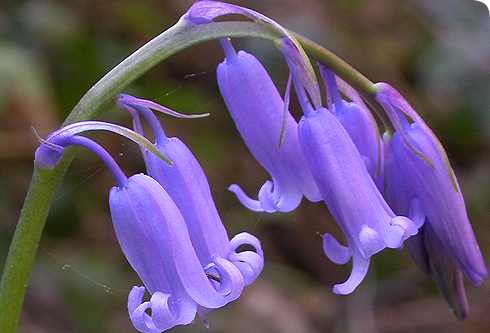Hyacinthoides non-scripta (British bluebell)
Hyacinthoides non-scripta the British bluebell is perhaps the most recognisable and best loved of our spring flowers.
The British bluebell carpets our woodland floors in countless millions, however this most characteristic of British plants has been the subject of growing concern as its survival is threatened.
Hyacinthoides non-scriptathe British bluebell is a close relative of the Spanish bluebell (Hyacinthoides hispanica).
Cultivars of the Spanish bluebell are now more commonly grown in British gardens than the British bluebell. Spanish bluebells are often incorrectly sold as British bluebells.
When garden waste is fly-tipped in the countryside the alien Spanish bluebells become established, interbreeding with the native British bluebells changing them forever.
Species detail
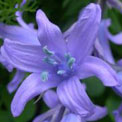
H. hispanica showing paler, broader open bell-shaped flowers with blue pollen. © F Rumsey
Molecular studies (Grundmann et al., 2010) indicate Hyacinthoides non-scripta and Hyacinthoides hispanica have a shared ancestor
Hyacinthoides non-scripta developed in isolation over 8,000 years, its range to the north of Hyacinthoides hispanica.
Areas of ancient genetic overlap allow the plant to breed and support intermediate plants, similar to those now found around Britain’s urban areas and in northern-central Spain.
Our horticultural activities we have in just over 250 years managed to start to undo the effects of at least 8,000 years of isolation.
However, hybrid plants in areas like Greater London may be better adapted to survive under some of the predicted climate change scenarios – so may be better hybrid Bluebells than no Bluebells?
-

Taxonomy
Get a detailed description of the form and structure of Hyacinthoides non-scripta.
-

Lookalikes
Learn about the similar looking relatives of Hyacinthoides non-scripta which it is interbreeding with and producing hybrids.
-

Habitat
Hyacinthoides non-scripta is most abundant in dominant in old woodlands on light-acid soils but will tolerate a range of soil conditions. Find out more about the various habitats in which the British bluebell is found.
-

Distribution
Widely distributed throughout Europe, find out the countries and areas in which Hyacinthoides non-scripta is found as well as the type of environment it grows in.
-

Conservation
Find out the conservation status of Hyacinthoides non-scripta, the legislation surrounding the species and why the continuing genetic purity of the surviving populations in urban areas and their environments is unlikely.
Images
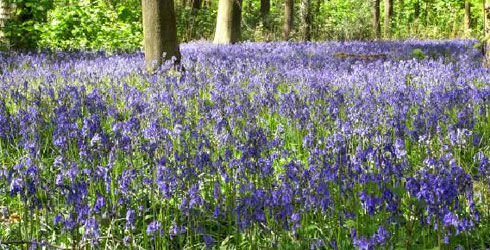
Hyacinthoides non scripta in a typical spring English woodland scene – Hampshire.
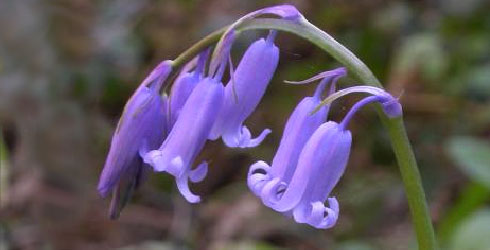
Typical flowering shot of Hyacinthoides non-scripta – narrowly bell-shaped, scented flowers with very reflexed tepals, the flowers turned to one side on a nodding inflorescence. Galicia, north-west Spain.
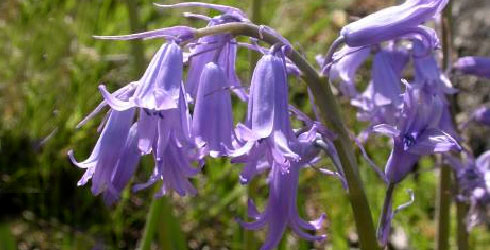
A naturally occurring hybrid in the Sistema Central, Spain.

H. hispanica showing paler, broader open bell-shaped flowers with blue pollen.
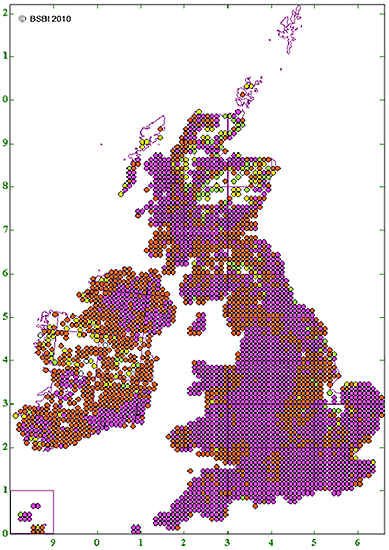
Map showing the British distribution of Hyacinthoides non-scripta. Green and yellow dots represent pre-1987 records, red dots represtent 1987 to 1999 records, pink dots represent 2000 to 2009 records. This is a static version of an interactive hectad map, available at www.bsbimaps.org.uk.
About the author

Dr Fred Rumsey
Botanist - Identification and Advisory Service, Angela Marmont Centre for UK Biodiversity.
